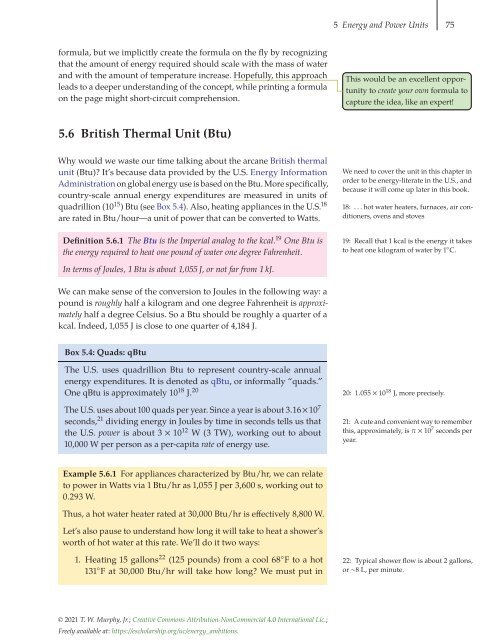Energy and Human Ambitions on a Finite Planet, 2021a
Energy and Human Ambitions on a Finite Planet, 2021a
Energy and Human Ambitions on a Finite Planet, 2021a
You also want an ePaper? Increase the reach of your titles
YUMPU automatically turns print PDFs into web optimized ePapers that Google loves.
5 <str<strong>on</strong>g>Energy</str<strong>on</strong>g> <str<strong>on</strong>g>and</str<strong>on</strong>g> Power Units 75<br />
formula, but we implicitly create the formula <strong>on</strong> the fly by recognizing<br />
that the amount of energy required should scale with the mass of water<br />
<str<strong>on</strong>g>and</str<strong>on</strong>g> with the amount of temperature increase. Hopefully, this approach<br />
leads to a deeper underst<str<strong>on</strong>g>and</str<strong>on</strong>g>ing of the c<strong>on</strong>cept, while printing a formula<br />
<strong>on</strong> the page might short-circuit comprehensi<strong>on</strong>.<br />
This would be an excellent opportunity<br />
to create your own formula to<br />
capture the idea, like an expert!<br />
5.6 British Thermal Unit (Btu)<br />
Why would we waste our time talking about the arcane British thermal<br />
unit (Btu)? It’s because data provided by the U.S. <str<strong>on</strong>g>Energy</str<strong>on</strong>g> Informati<strong>on</strong><br />
Administrati<strong>on</strong> <strong>on</strong> global energy use is based <strong>on</strong> the Btu. More specifically,<br />
country-scale annual energy expenditures are measured in units of<br />
quadrilli<strong>on</strong> (10 15 ) Btu (see Box 5.4). Also, heating appliances in the U.S. 18<br />
are rated in Btu/hour—a unit of power that can be c<strong>on</strong>verted to Watts.<br />
Definiti<strong>on</strong> 5.6.1 The Btu is the Imperial analog to the kcal. 19 One Btu is<br />
the energy required to heat <strong>on</strong>e pound of water <strong>on</strong>e degree Fahrenheit.<br />
We need to cover the unit in this chapter in<br />
order to be energy-literate in the U.S., <str<strong>on</strong>g>and</str<strong>on</strong>g><br />
because it will come up later in this book.<br />
18: . . . hot water heaters, furnaces, air c<strong>on</strong>diti<strong>on</strong>ers,<br />
ovens <str<strong>on</strong>g>and</str<strong>on</strong>g> stoves<br />
19: Recall that 1 kcal is the energy it takes<br />
to heat <strong>on</strong>e kilogram of water by 1 ◦ C.<br />
In terms of Joules, 1 Btu is about 1,055 J, or not far from 1 kJ.<br />
We can make sense of the c<strong>on</strong>versi<strong>on</strong> to Joules in the following way: a<br />
pound is roughly half a kilogram <str<strong>on</strong>g>and</str<strong>on</strong>g> <strong>on</strong>e degree Fahrenheit is approximately<br />
half a degree Celsius. So a Btu should be roughly a quarter of a<br />
kcal. Indeed, 1,055 J is close to <strong>on</strong>e quarter of 4,184 J.<br />
Box 5.4: Quads: qBtu<br />
The U.S. uses quadrilli<strong>on</strong> Btu to represent country-scale annual<br />
energy expenditures. It is denoted as qBtu, or informally “quads.”<br />
One qBtu is approximately 10 18 J. 20<br />
The U.S. uses about 100 quads per year. Since a year is about 3.16×10 7<br />
sec<strong>on</strong>ds, 21 dividing energy in Joules by time in sec<strong>on</strong>ds tells us that<br />
the U.S. power is about 3 × 10 12 W (3 TW), working out to about<br />
10,000 W per pers<strong>on</strong> as a per-capita rate of energy use.<br />
20: 1.055 × 10 18 J, more precisely.<br />
21: A cute <str<strong>on</strong>g>and</str<strong>on</strong>g> c<strong>on</strong>venient way to remember<br />
this, approximately, is π × 10 7 sec<strong>on</strong>ds per<br />
year.<br />
Example 5.6.1 For appliances characterized by Btu/hr, we can relate<br />
to power in Watts via 1 Btu/hr as 1,055 J per 3,600 s, working out to<br />
0.293 W.<br />
Thus, a hot water heater rated at 30,000 Btu/hr is effectively 8,800 W.<br />
Let’s also pause to underst<str<strong>on</strong>g>and</str<strong>on</strong>g> how l<strong>on</strong>g it will take to heat a shower’s<br />
worth of hot water at this rate. We’ll do it two ways:<br />
1. Heating 15 gall<strong>on</strong>s 22 (125 pounds) from a cool 68 ◦ F toahot 22: Typical shower flow is about 2 gall<strong>on</strong>s,<br />
131 ◦ F at 30,000 Btu/hr will take how l<strong>on</strong>g? We must put in or ∼8 L, per minute.<br />
© 2021 T. W. Murphy, Jr.; Creative Comm<strong>on</strong>s Attributi<strong>on</strong>-N<strong>on</strong>Commercial 4.0 Internati<strong>on</strong>al Lic.;<br />
Freely available at: https://escholarship.org/uc/energy_ambiti<strong>on</strong>s.


















